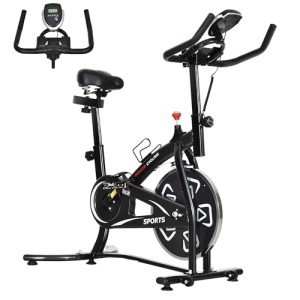The Benefits and Mechanics of Using a Bicycle for Workout
Cycling, a flexible and effective type of exercise, has been acquiring appeal as a low-impact, high-reward activity. Whether you're an experienced professional athlete or a newbie aiming to enhance your fitness, riding a bicycle can offer a vast array of health benefits. This short article explores the mechanics of cycling as a workout, its physical and psychological advantages, and provides ideas for getting going.
Introduction to Cycling as a Workout
Cycling is a low-impact, full-body exercise that can be adjusted to different fitness levels and goals. It mainly targets the lower body, but it likewise engages the core and upper body, making it a thorough workout. Whether you're cycling outdoors on a road bike or indoors on a stationary bike, the advantages are various.
Physical Benefits of Cycling
Cardiovascular Health
- Cycling is an outstanding cardiovascular exercise that assists improve heart health. It increases heart rate, enhances lung capacity, and enhances circulation, decreasing the danger of heart problem, stroke, and high blood pressure.
Muscle Strengthening
- Cycling mainly works the quadriceps, hamstrings, calves, and glutes. It likewise engages the core muscles for stability and the upper body for balance and steering. Routine cycling can result in more powerful, more toned muscles.
Weight Management
- Cycling is a high-calorie-burning activity. Depending on the strength and duration, a 150-pound person can burn around 500-800 calories per hour. This makes it an efficient tool for weight reduction and weight management.
Joint Health
- Unlike high-impact exercises like running, cycling is mild on the joints. It supplies a low-impact way to remain active, making it suitable for people with joint pain or injuries.
Enhanced Balance and Coordination
- Cycling needs balance and coordination, which can improve in time. This can be especially advantageous for older adults or those recovering from injuries.
Psychological Benefits of Cycling
Tension Reduction
- Cycling can be a meditative and peaceful activity. The rhythmic movement and the outdoors can help decrease stress and anxiety, promoting mental wellness.
Mental Clarity
- Exercise, consisting of cycling, launches endorphins, which are natural state of mind lifters. This can enhance psychological clarity and cognitive function.
Boost in Confidence
- Attaining fitness objectives, whether it's completing a long trip or enhancing speed, can improve self-esteem and confidence.
Types of Bicycles for Workouts
Road Bicycles
- Developed for speed and effectiveness on paved roads, road bikes are lightweight and have thin, smooth tires. They are ideal for long-distance rides and enhancing cardiovascular fitness.
Mountain Bicycles
- Developed for off-road surface, mountain bicycle have wider, knobby tires and a durable frame. They are outstanding for constructing strength and endurance, specifically in uneven or rough surface.
Hybrid Bicycles
- Integrating elements of road and mtb, hybrid bikes use versatility. They are suitable for both paved and unpaved surface areas and are fantastic for basic fitness and commuting.
Stationary Bicycles
- Suitable for indoor exercises, stationary bicycles can be adjusted for resistance and intensity. They are practical for all weather and can be used for interval training and high-intensity exercises.
Tips for Getting Started
Choose the Right Bike
- Select a bike that fits your fitness objectives and comfort level. Think about Online Stationary Bikes like terrain, range, and spending plan.
Purchase Safety Gear
- Constantly use a helmet, and consider other security gear like gloves, knee pads, and reflective clothes, specifically if you're cycling outdoors.
Start Slow
- If you're brand-new to cycling, start with brief, easy trips and slowly increase the duration and strength. This helps avoid injuries and develop endurance.
Stay Hydrated and Fueled
- Consume plenty of water previously, throughout, and after your trips. Eat a well balanced diet to fuel your workouts and aid healing.
Join a Community
- Think about joining a cycling club or group to remain determined and meet like-minded people. This can also provide chances for group trips and training.
Frequently asked questions
Q: Is cycling a great workout for novices?
- Yes, cycling is an outstanding workout for beginners. It is low-impact, easy to learn, and can be adjusted to numerous fitness levels. Start with short, simple rides and gradually increase the strength and period.
Q: How frequently should I cycle for fitness?
- Go for at least 150 minutes of moderate-intensity cycling each week, or 75 minutes of vigorous-intensity cycling. This can be broken down into much shorter, more frequent sessions, such as 30 minutes, 5 times a week.
Q: Can cycling help with weight reduction?
- Yes, cycling is a high-calorie-burning activity that can aid with weight loss and weight management. Combine it with a healthy diet for best outcomes.
Q: What are the very best times to cycle for a workout?
- The very best time to cycle depends upon your schedule and choices. Morning rides can assist kickstart your metabolism and increase energy levels, while night rides can be a great way to relax after a long day.
Q: Do I require special clothing for cycling?
- While you don't require unique clothing, comfortable, breathable gear is advised. Consider cycling shorts for comfort and a moisture-wicking top to remain dry. If Stationary Bikes Online , reflective clothes can improve presence.
Cycling is a flexible and gratifying form of exercise that provides many physical and psychological advantages. Whether you're cycling outdoors or inside your home, it can be tailored to your fitness objectives and choices. By choosing the ideal bike, investing in safety equipment, and following some basic suggestions, you can enjoy a fulfilling and effective workout. So, hop on a bike and begin pedaling your method to much better health and well-being.

